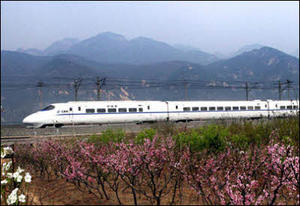InfrastructureChina reduces top speed on high-speed rail
On Monday Chinese officials lowered the top operating speed for its flagship bullet train citing safety concerns; China’s Railway Ministry will now run trains at 155 to 186 miles per hour on the Beijing to Shanghai line instead of 236 miles per hour as was originally planned; the recent announcement comes as part of broader set of changes to the Railway Ministry after Liu Zhijun, the previous minister, was fired for corruption and mismanagement in February

On the Beijing to Shanghai route // Source: democraticunderground.com
On Monday Chinese officials lowered the top operating speed for its flagship bullet train citing safety concerns.
China’s Railway Ministry will now run trains at 155 to 186 miles per hour on the Beijing to Shanghai line instead of 236 miles per hour as was originally planned.
The foreign companies that originally sold China the high-speed rail technology say that the trains were not designed to handle speeds of 215 miles per hour. The Rail Ministry brushed these concerns aside, stating that Chinese engineers had made improvements to the original technology that would allow it to safely operate at such speeds.
The reduced speed on the bullet train’s mainline will now match the speeds of the eight other high-speed rail lines that are currently being built.
The recent announcement comes as part of broader set of changes to the Railway Ministry after Liu Zhijun, the previous minister, was fired for corruption and mismanagement in February.
Following the leadership shakeup, the ministry inspected the Beijing to Shanghai line and declared that it was safe for use. Officials say that the most recent change in speed comes as a result of other safety hazards like inadequately secured tracks and mines built near railways.
Hu Yadong, the vice rail minister, added that the trains were capable of running at higher speeds, but officials chose to reduce the speed limit to allow for more traditional and affordable trains to operate. This move would allow the ministry to save money on operations, maintenance, and power costs.
Critics of China’s high speed rail argue that the lines are poorly built and too expensive for average citizens to ride.
To make tickets more affordable, high speed rail officials have decided not to go ahead with plans to build luxury compartment, choosing instead to offer cheaper classes of service.
The cheapest fare of $63 is still prohibitively expensive for the average Chinese resident as it equals the net monthly income for rural residents.
China has aggressively invested in its high-speed rail system spending $750 billion to install nearly 8,100 miles of high speed rail lines and 11,000 miles of normal railways.
